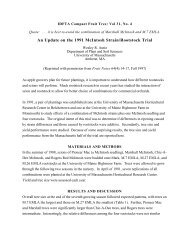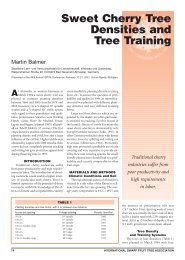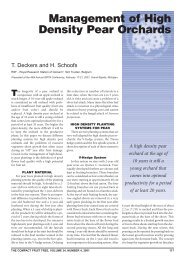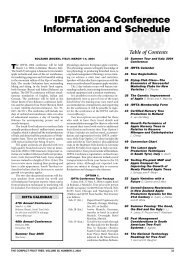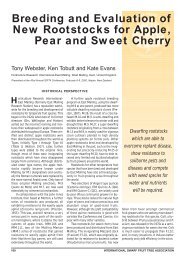Factors Influencing Apple Fruit Firmness - Virtual Orchard
Factors Influencing Apple Fruit Firmness - Virtual Orchard
Factors Influencing Apple Fruit Firmness - Virtual Orchard
You also want an ePaper? Increase the reach of your titles
YUMPU automatically turns print PDFs into web optimized ePapers that Google loves.
Quote: <strong>Fruit</strong> firmness . . . is a characteristic that tends to be influenced greatly by manypreharvest and postharvest factors.FACTORS INFLUENCING APPLE FRUIT FIRMNESSJennifer R. DeEll, Fadia Saad and Shahrokh KhanizadehHorticultural Research and Development Center, Agriculture and Agri-Food Canada430 Gouin Blvd, St-Jean-sur-Richelieu, Québec J3B 3EBPresented at the 42 nd Annual IDFTA Conference, February 20-24, 1999, Hamilton, Ontario.<strong>Fruit</strong> firmness is one of the most important characteristics of apple quality. Unfortunatelyhowever, it is also a characteristic that tends to be influenced greatly by many preharvest andpostharvest factors. Obtaining and maintaining apple fruit firmness from the orchard through tothe consumer, therefore, tends to be one of the major issues facing apple producers. <strong>Apple</strong>s witha firmness of less than 4.5 kg (9.9 lb) are usually rejected by consumers and, therefore, this is theminimum acceptable firmness level for many soft cultivars (Prange et al., 1993). This article is abrief summary, with limited references as examples, of factors that have been shown to affectapple fruit firmness.PREHARVEST FACTORSMost apple quality characteristics, including fruit firmness, are genetically controlled and thusvary with cultivar. For example, Granny Smith apples are firmer than most other cultivars,whereas McIntosh apples are among the softest (Malenfant, 1998). The strain within a particularcultivar can also influence fruit firmness, such as standard-type McIntosh strains (e.g., Redmaxand Marshall) which tend to be 0.45 kg (1 lb) firmer than the spur-type strains (e.g., Macspur)both at harvest and after storage (DeEll and Prange, 1994). Rootstocks may have an effect onapple firmness, but this tends to vary with cultivar and/or strain (Drake et al., 1993).There are conflicting reports as to the relationship between calcium (Ca) content and apple fruitfirmness. Bramlage et al. (1979) found McIntosh fruit firmness at harvest to increase slightlywith increased flesh Ca concentration. However, the firmness of McIntosh apples does notappear to be influenced by preharvest sprays of CaCl or other commercially available Ca2mixtures (Bramlage et al., 1985). Similarly, preharvest CaCl sprays do not affect the Ca content2or fruit firmness of other cultivars, such as Wellspur Delicious (Davenport and Peryea, 1990).On the other hand, Golden Delicious, Delicious and Cox’s Orange Pippin apples receiving Cafoliar applications have been shown to be 2.2 to 3.5 Newtons (0.5-0.8 lb) firmer than therespective nontreated apples (Raese and Drake, 1993; Watkins et al., 1989). In some cases,preharvest Ca sprays seem to be effective only when applied very often (18 times during thegrowing season) or at very high rates that would damage apple skin (Peryea, 1991; Weis et al.,1980).Nitrogen (N) application does not appear to influence apple fruit firmness (Opara et al., 1997).However, high-N fruit tend to be larger, softer, more prone to preharvest drop, and more likely todevelop physiological disorders in storage (Bramlage et al., 1980). <strong>Fruit</strong> size may be alsocorrelated negatively with firmness at harvest and after storage. Boron (B) sprays do not appearto influence apple fruit firmness (Peryea and Drake, 1991), while some phosphate compounds
applied as foliar sprays can improve fruit firmness of certain cultivars (Webster and Lidster,1986).<strong>Apple</strong> trees are sprayed with several sprays in order to control vegetative growth, hasten or delayripening, delay apple abscission, and/or to simply enhance apple quality characteristics.However, many of these compounds also affect fruit firmness. The use of CPPU (N-(2-chloro-4-pyridyl)-N’-phenylurea, also known as fencloypr, KT-30, 4-PU and CN-11-3183) results infirmer fruit for some apple cultivars but not for others (Curry and Greene, 1993); SADH(succinic acid 2,2-dimethyl hydrazide, Alar TM , B-9, or daminozide) generally results in greaterfruit firmness but when other sprays (e.g., ethephon) are also used, reduced firmness may result(Greene et al., 1972); NAA (naphthaleneacetic acid) has little influence on apple fruit firmness(Marini et al., 1993); paclobutrazol generally results in firmer apples (Wang and Steffens, 1987);whereas AVG (aminoethoxyvinylglycine, ReTain TM ) tends to cause firmer fruit at harvest but theeffect is lost during storage (Greene, 1996).Other cultural practices such as crop density, root pruning, trunk scoring, and trunk ringing alsoaffect apple fruit firmness. <strong>Apple</strong>s appear to be slightly firmer when produced from trees withlow crop density, compared to fruit from trees with high crop density (Opara et al., 1997). <strong>Fruit</strong>firmness may be also greater when apple tree roots are pruned, depending on the time of pruning(Schupp and Ferree, 1987). Trunk scoring and ringing may affect apple fruit firmness,depending on cultivar (Elfving et al., 1991). Water management also plays a role in determiningfruit firmness. For example, fruits from nonirrigated apple trees may be firmer than those fromirrigated trees, depending on cultivar and the type of irrigation (Opara et al., 1997).POSTHARVEST FACTORSMaturity at harvest can affect apple fruit firmness. Some apple cultivars (e.g., Golden Deliciousand Redchief Delicious) show decreased fruit firmness with later harvest dates (Ait-Oubahou etal., 1995), whereas other cultivars (e.g., Starking Delicious) do not seem to be affected byharvest time (Sfakiotakis et al., 1993). Maturity at harvest can also affect the rate at whichapples soften during storage. For example, earlier harvested Cox’s Orange Pippin apples havegreater firmness retention during storage than later harvested apples (Tu et al., 1997). Althoughethylene production of apples is associated with increased maturity, fruit firmness is notnecessarily related to ethylene production (Gussman et al., 1993).Postharvest heat treatments, e.g., 38˚C (100.4˚F) for 4 days, have been shown to improvefirmness retention of some apple cultivars during storage (Klein and Lurie, 1990). However, notall apple cultivars respond positively to prestorage heating. For example, holding McIntoshapples at 38 to 40˚C for 1 to 3 days results in firmness reduction (Chiu, 1984). Dipping heattreatedapples in a CaCl solution tends to increase the effect of heating on firmness (Lurie and2Klein, 1992).Postharvest Ca dips or infiltration (e.g., 4% CaCl ) increases fruit Ca content and reduces2firmness loss for many apple cultivars (Mason et al., 1974; Sams and Conway, 1984). However,Ca uptake may vary enormously with apple cultivar (Lidster and Porritt, 1978) and rootstock(Pirmoradian and Babalar, 1995), as well as with different orchards and maturity at harvest for agiven cultivar (Abbott et al., 1989). The source of Ca also influences its effect on apple fruitfirmness (Beavers et al., 1994), and the addition of surfactants or thickeners to the Ca solutionfurther improves firmness retention (Mason et al., 1975).
Other chemicals may also improve firmness retention in apples, even though that is not theirprimary use. For example, diphenylamine (DPA) is used to control storage scald, a physiologicaldisorder of apple characterized by diffuse browning of the skin. However, DPA dips tend to alsoimprove firmness retention (Lurie et al., 1989). The use of a sucrose fatty acid polyester (SPE)coating, also known as Semperfresh TM , or diazocyclopentadiene (DACP), an inhibitor ofethylene-binding, also reduces firmness loss in apples (Blankenship and Sisler, 1993; Drake etal., 1987).Temperature is the single most important factor governing the maintenance of postharvestquality, and therefore rapid cooling after harvest greatly improves firmness retention in applesduring storage. Low storage temperatures are equally important, as McIntosh apples have beenshown to soften as much as 20 times faster at 20˚C than at 0˚C (Lidster et al., 1988).Many apple cultivars held in controlled atmosphere (CA) storage have improved fruit firmnessretention and longer storage life. Standard CA conditions generally consist of 2-3% oxygen (O )2and 2-4% carbon dioxide (CO ), although for some apple cultivars low O (1-2% O , 1-2% CO )2222is also used, and in some places even ultra-low O (0.7-0.9% O ,
Curry, E.A. and D.W. Greene. 1993. CPPU influences fruit quality, fruit set, return bloom, andpreharvest drop of apples. HortScience 28:115-119.Davenport, J.R. and F.J. Peryea. 1990. Whole fruit mineral element composition and quality ofharvested ‘Delicious’ apples. J. Plant Nutr. 13:701-711.DeEll, J.R. and R.K. Prange. 1992. Postharvest quality and storage of scab-resistant applecultivars. HortTechnol. 2:352-358.DeEll, J.R. and R.K. Prange. 1994. Maturity and storage requirements of McIntosh andCortland strains, p. 86-87. In: Annual Report of the Nova Scotia <strong>Fruit</strong> Growers’ Association.Drake, S.R., J.K. Fellman and J.W. Nelson. 1987. Postharvest use of sucrose polyesters forextending the shelf-life of stored ‘Golden Delicious’ apples. J. Food Sci. 52:1283-1285.Drake, S.R., F.E. Larsen and S.S. Higgins. 1993. Greenspur on selected rootstocks – a bettergreen. Good <strong>Fruit</strong> Grower 44(17):75-77.Elfving, D.C., E.C. Loughheed and R.A. Cline. 1991. Daminozide, root pruning, trunk scoring,and trunk ringing effects on fruit ripening and storage behavior of ‘McIntosh’ apple. J.Amer. Soc. Hort. Sci. 116:195-200.Greene, D.W. 1996. AVG: a new preharvest drop control compound for apples. New England<strong>Fruit</strong> Meetings 102:79-84.Greene, D.W., W.J. Lord, F.W. Southwick and W.J. Bramlage. 1972. Interactions of SADH(Alar), ethephon and preharvest drop control chemicals on quality of McIntosh apples. NewEngland <strong>Fruit</strong> Meetings 78:85-91.Gussman, C.D., J.C. Goffreda and T.J. Gianfagna. 1993. Ethylene production and fruitsofteningrates in several apple fruit ripening variants. HortScience 28:135-137.Klein, J.D. and S. Lurie. 1990. Prestorage heat treatment as a means of improving postharvestquality of apples. J. Amer. Soc. Hort. Sci. 115:265-269.Kupferman, E. 1997. Controlled atmosphere storage of apples. Proc. 7 th InternationalControlled Atmosphere Research Conference 2:1-30.Lau, O.L. 1983. Storage responses of four apple cultivars to a ‘rapid CA’ procedure incommercial controlled atmosphere facilities. J. Amer. Soc. Hort. Sci. 108:530-533.Lau, O. L. 1989. Responses of British Columbia- grown apples to low-oxygen and lowethylenecontrolled atmosphere storage. Acta Hort. 258:107-114.Lidster, P.D. and S.W. Porritt. 1978. Some factors affecting uptake of calcium by apples dippedafter harvest in calcium chloride solution. Can. J. Plant Sci. 58:35-40.Lidster, P.D., P.D. Hildebrand, L.S. Bérard, and S.W. Porritt. 1988. Commercial storage of fruitsand vegetables. Agriculture Canada Publication 1532/E.Lurie, S. and J.D. Klein. 1992. Calcium and heat treatments to improve storability of ‘Anna’apples. HortScience 27:36-39.Lurie, S., J. Klein and R. Ben-Arie. 1989. Physiological changes in diphenylamine-treated‘Granny Smith’ apples. Israel J. Bot. 38:199-207Malenfant, D. 1998. Enquête détaillants : la qualité a sa place, p. 11-14. In: Proc. CliniquePomme, Journée Horticoles Régionales, Saint-Rémi, Québec.Marini, R.P., R.E. Byers and D.L. Sowers. 1993. Repeated applications of NAA controlpreharvest drop of ‘Delicious’ apples. J. Hort. Sci. 68:247-253.Mason, J.L., B.G. Drought and J.M. McDougald. 1974. Effect of a calcium chloride dip onsenescent breakdown, firmness and calcium concentration in ‘Spartan’ apple. HortScience9:596.Mason, J.L., J.J. Jasmin and R.L. Granger. 1975. Softening of ‘McIntosh’ apples reduced by apost-harvest dip in calcium chloride solution plus thickener. HortScience 10:524-525.
Opara, L.U., C.J. Studman and N.H. Banks. 1997. Physico-mechanical properties of ‘Gala’apples and stem-end splitting as influenced by orchard management practices and harvestdate. J. Agr. Eng. Res. 68:139-146.Peryea, F.J. 1991. Preharvest calcium sprays and apple firmness. Good <strong>Fruit</strong> Grower42(13):12-15.Peryea, F.J. and S.R. Drake. 1991. Influence of mid-summer boron sprays on boron content andquality indices of ‘Delicious’ apple. J. Plant Nutr. 14:825-840.Pirmoradian, M. and M. Babalar. 1995. Effect of rootstock and postharvest application of CaCl2during storage of Red Delicious apple on ethylene production and some qualitative factors.Iranian J. Agr. Sci. 26:69-76.Prange, R.K., M. Meheriuk, E.C. Lougheed and P.D. Lidster. 1993. Harvest and storage, p. 64-69. In: C.G. Embree (ed.), Producing <strong>Apple</strong>s in Eastern and Central Canada. AgricultureCanada, Publication 1899/E.Raese, J.T. and S.R. Drake. 1993. Effects of preharvest calcium sprays on apple and pearquality. J. Plant Nutr. 16:1807-1819.Sams, C.E. and W.S. Conway. 1984. Effect of calcium infiltration on ethylene production,respiration rate, soluble polyuronide content, and quality of ‘Golden Delicious’ apple fruit.J. Amer. Soc. Hort. Sci. 109:53-57.Schupp, J.R. and D.C. Ferree. 1987. Effect of root pruning at different growth stages on growthand fruiting of apple trees. HortScience 22:387-390.Sfakiotakis, E., G. Naonos, G. Stavroulakis and M. Vassilakakis. 1993. Effect of growinglocation, harvest maturity and ventilation during storage on ripening and superficial scald of‘Starking Delicious’ apples. Acta Hort. 326:231-235.Tu, K., K. Waldron, L. Ingham, T. De Barsy and J. De Baerdemaeker. 1997. Effect of pickingtime and storage conditions on ‘Cox’s Orange Pippin’ apple texture in relation to cell wallchanges. J. Hort. Sci. 72:971-980.Wang, C.Y. and G.L. Steffens. 1987. Postharvest responses of ‘Spartan’ apples to preharvestpaclobutrazol treatment. HortScience 22:276-278.Watkins, C.B., E.W. Hewett, C. Bateup, A. Gunson and C.M. Triggs. 1989. Relationshipsbetween maturity and storage disorders in ‘Cox’s Orange Pippin’ apples as influenced bypreharvest calcium or ethephon sprays. New Zealand J. Crop Hort. Sci. 17:283-292.Webster, D.H. and P.D. Lidster. 1986. Effects of phosphate sprays on McIntosh apple fruit andleaf composition, flesh firmness and susceptibility to low-temperature disorders. Can. J.Plant Sci. 66:617-626.Weis, S.A., M. Drake, W.J. Bramlage and J.H. Baker. 1980. A sensitive method for measuringchanges in calcium concentration in ‘McIntosh’ apples demonstrated in determining effectsof foliar calcium sprays. J. Amer. Soc. Hort. Sci. 105:346-349.



